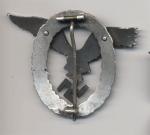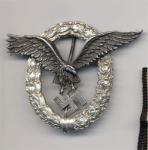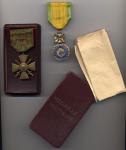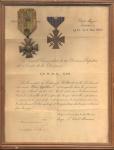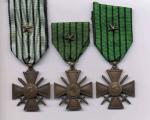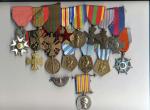-
Posts
2,284 -
Joined
-
Last visited
-
Days Won
6
Content Type
Profiles
Forums
Blogs
Gallery
Events
Store
Everything posted by PKeating
-

Heer Soldbuch, of interest...
PKeating replied to Ralph A's topic in Wehrmacht Medals, Decorations & Awards
Points conceded. PK -
-
-

Heer Soldbuch, of interest...
PKeating replied to Ralph A's topic in Wehrmacht Medals, Decorations & Awards
Or into a hole, Don! Bew?hrungs-Soldaten - disciplinary probationers - were often men convicted of relatively minor offences and assigned to hard labour or dangerous occupations like mine clearance as non-citizens, deprived of their military and civil status. They would take the chance, when offered, to volunteer for combat duties with what they called Himmelsfahrt units, the soldiers' slang for Bew?hrungs-Bataillonen. This term translates as "Heavenbound unit", meaning suicide unit. As you can imagine, the casualty rate was quite high in such units. The carrot offered to these "lost souls" was rehabilitation through redemption of their lost honour on the field of battle. Many realised, doubtless as they lay coughing up their lifesblood in those final seconds before darkness claimed them, that it was simply exchanging a slow death in, say, the quarries of Mauthausen for a quicker death in battle. But death rehabilitated them so the family received any benefits going...and a nice letter from the CO with the dearly departed's medals and documents. In some cases, they were rehabilitated before they were killed, like Heinrich Stadlbauer here. Mind you, one can only guess at the state he was in as a Gold Wound Badge holder! Light duties only, I expect. Half the initial intake of SS-Fallschirmj?ger-Btl 500 in November and December 1943 consisted of Bew?hrungs-Schutzen from various Waffen-SS punishment camps and labour battalions. They were deprived of the right to wear the sigrunen, to hold any rank above the lowest recruit level grade and to wear their decorations. They underwent jump training and were awarded, on paper, their jump badges. The unit was effectively wiped out twice during its year of existence, from October 1943 to October 1944, when the ninety survivors, plus men under training with the Field Training & Replacement Company, were posted to the newly forming SS-Fallschirmj?ger-Btl 600. There is a poignant little reference in the Signals Platoon war diary - an unofficial diary kept by a signaller who is still alive - to the last of the B-Schutzen removing their blank righthand collar patches and replacing them with the runic patches as they are transferred to the new unit. Only a handful of them, perhaps thirty of the survivors, were left out of between five and six hundred volunteers a year before. As a footnote of relevance to collectors of photography, one of the reasons for the rarity of photos of SS paratroopers wearing jump badges is that more than half the volunteers for SS-FJ-Btl 500 were not allowed to wear any badges until they were rehabilitated. The men you see wearing badges are always seen with runic collar patches and are often NCOs. A Heinrich Stadlbauer shows up in the German war graves records so it looks as if he didn't survive WW2. Is this the Heinrich Stadlbauer whose documents you have? Is it the same DoB? PK -

Heer Soldbuch, of interest...
PKeating replied to Ralph A's topic in Wehrmacht Medals, Decorations & Awards
He was certainly a Bew?hrungs-Schutze. Infanterie-Ersatz-Bataillon 500 was formed in Fulda in October 1941 from Infanterie-Ersatz-Btl 500 and was subordinate to Division 159. Hainrich Stadibauer won the IC2, IAB and Silver Wound Badge at the same time, having received the Black Wound Badge in 1942. The soldbuch entry gives the award date for the Gold badge as 2.5.1944 and all the entries are by the same Landessch?tzen-Bataillon 501 officer, Stadibauer's company commander. However, the soldbuch is not a duplicate so this shows that while Stadibauer was awarded these decorations, he did not actually receive them and would not have been entitled to wear them until after his 'rehabilitation'. The Gold WB document was issued at Skierniewieze, which was where the HQ of Infanterie-Ersatz-Bataillon 500 was located during its time in Poland in 1943 and 1944. Infanterie-Ersatz-Bataillon 500 had been transferred in December 1943 to the Generalgouvernement (Poland), forming the nucleus of a training battalion with five companies. In 1944, the unit was enlarged to regimental size and moved to B?hmen-M?hren (Czechoslovakia). The Gold WB document was presumably filled out by the CO of Infanterie-Ersatz-Bataillon 500 before Stadibauer was posted off to Landessch?tzen-Bataillon 501 as a rehabilitated soldier and citizen. PK -
You've just seen one! Look above at the 1940 example I posted. The star device denoted the level of citation or subsequent awards but the cross could be awarded for an act of valour not mentioned in a dispatch to headquarters...if that makes sense. PK
-
The WW1 air ace Guynemer, who had fifty-four victories, had twenty-seven palms on his riband, some of which, I think, were the silver class instituted later in the war to replace five bronze palms. Guynemer also had dozens of bronze and silver stars. His riband was about eighteen inches long! The WW2 ace Pierre Clostermann accumulated about a dozen palms. Just for the benefit of those readers unfamiliar with the terms of the decoration, the Croix de Guerre was instituted on 8.4.1915 and was the only decoration awarded by France in World War One purely for valour on the battlefield. It was awarded to individuals of any rank who distinguished themselves by heroism in combat against enemy forces and also to anyone mentioned in dispatches for bravery in action. Subsequent acts of bravery on the part of recipients earned a bronze star for Regimental and Brigade citations, a silver star for Divisional citations, a gold star for Corps citations and a bronze palm leaf for Army citations. A common soldier of lowly rank from the mud and filth of the trenches sporting the Palme de Bronze on his green and red ribbon was a man to be treated with the greatest of respect. As we have seen, the Croix de Guerre could also be awarded to units that distinguished themselves. The above summary answers the question of the member who asked it there were crosses with just the date '1914' on the reverse medallion. The short answer is no. They run 1914-1915, 1914-1916 (quite rare), 1914-1917 and 1914-1918. I am told that there was a 1914-1919 issue for soldiers serving in the Balkans and with the expeditionary forces in White Russia but have never seen one of these. There are some wonderful things coming out of the woodwork in this thread, aren't there?
-
As you rightly point out, Andrew, sentiment cannot be a prime mover in the even-handed assessment of any legal case. But I am certain that a proportion of the cases could be reviewed and soldiers' names cleared, if only on the basis of "reasonable doubt" of their guilt as charged. There again, perhaps it is best to let it lie. Most people understand that many of the men shot did not deserve to die in that way and maybe it is kinder to allow families to convince themselves that the man in the faded photograph was not a coward or a felon but merely the victim of unjust punishment. PK
-
Here's one from WW2. This was awarded to Pierre Ursault, a motorcycle reconnaissance rider serving with an artillery unit in 1940, for undertaking particularly risky missions between June 11th and 19th 1940, "often in very critical situations", which means that Ursault must have ridden into the lion's mouth so to speak, as the French Army fell back in front of the rapid German advance. You can't see it here, of course, but another thing that makes this ensemble interesting is that the cross is a 1939-1940 issue, meaning that it is the Vichy pattern, approved for wear by the P?tain administration. So Ursault probably served in the new French Army or one of the paramilitary organisations. In further support of this thesis is the fact that the riband is the so-called "London type", meaning that it is of British manufacture. Perhaps Ursault quickly acquired the correct Republican riband after the Liberation and threw away his Vichy riband? This item was rescued from a pile of trash outside a recently deceased widow's appartment building by a 'picker' who calls me when he gets nice things. Someone chucked this in the trash! PK
-
Another nice line up. I would rate the French Croix de Guerre alongside the Iron Cross and the British Military Cross in asthetic terms. Such simple but eloquent designs. Don't know who this fellow was but he was active: six bronze palms. One of them is missing but the holes are there in the riband. Probably a flyer. The Bronze Palm represented a citation in Army dispatches. You had to do something very special to get the Palm. Flyers got one for each aerial victory. So it is reaosnable to presume that this cross was to a pilot because it would have very hard for a soldier or a sailor to accumulate six of them. PK
-
The citation, which is on very fine paper and printed askew. Only one of the French collectors I know had ever seen one of these before. PK
-
You can find medals with cases from time to time in France. I have a couple of coin dealers and flea market dealers who call me when they get stuff. The problem in France, you see, is that the majority of ordinary people, when clearing out a late elderly relative's home, keep the medals to sell because they are made of metal and throw just about anything made of paper, including photographs, in the rubbish skip (dumptster, for our cousins across the Atlantic). Here is another ensemble. I looked in the M?daille Militaire box, which is deliberately deep enough for two medals, and found these two medals, unworn. But tucked into the lid of the box was this citation, which is an extremely rare item. Poor Gaston Blanchard did not have much luck; he fell at the Battle of Rosalies on August 22nd 1914. He was posthumously decorated with the Crois de Guerre with Bronze Star, suggesting that he was mentioned in regimental or brigade dispatches, and then he was accorded the fairly rare distinction of a posthumous M?daille Militaire, normally only awarded to NCOs for bravery or General Officers for leadership. PK
-
That's a really nice line-up of 14-18 Croix de Guerre, Darrell. Vraiement dans leur jus. Here's something I reckon you'll appreciate. I found it in a fleamarket, complete with the dried violet, which the French adopted in the way that the British and Commonwealth adopted the poppy. Whoever the veteran was, he must put the flower in the case at some point, maybe after a reunion. It's rather touching, isn't it? PK
-
Thank you, Rick! So I was misreading the 'T' as a 'J'. Now that I look at it again, of course I was! Thanks, old chap. I owe you one. PK
-
It just goes to show that real treasures can still be found if you're prepared to do the study and the legwork. Here is a Croix de Guerre citation I picked up here in Paris a while ago. The chap who sold it didn't really understand its significance, first of all that it is a Croix de Guerre unit citation and, moreover, to an American unit. Below is an extract from a history of SSU 8/SSU 628, mentioning the gas attacks of April 17th and 18th and the unit citation. It also mentions that Lt Bollaert, the French liason officer, was later KIA. What is interesting is the name of the American OC, Lt Appleton J Miles, who has also signed the document across the unit stamp. He was surely a relative of the Indian Wars general and CMoH recipient Nelson Appleton Miles. A grandson, perhaps? Can any of you US Army history buffs help me with this? PK From "Memorial Volume of the American Field Service in France, Friends of France, 1914 - 1918"
-
Obviously some of the men executed were dispatched in proper accordance with the law, such as it was in those days, but the fact remains that many men were shot pour encourager les autres, as the French put it. There was a French NCO shot for "mutiny" after refusing to wear the repaired trousers of a man who had died of his wounds. It's a well-documented case about which a film was made. My grandfather had to officiate at several executions, both on the Western Front and later during the Irish Civil War. One of the executions involved, apparently, a nineteen year old found wandering in a confused state on the battlefield without his weapon or webbing. He was charged with desertion in the face of the enemy, with throwing away his rifle and equipment - as per Sgt Stones - and shot. My grandfather said that the boy did not understand why he was being killed and begged for his life. One can only try to imagine the scene and how everyone involved in it felt. There is a difference between meting out military justice to a deserving criminal and aiming a rifle at a terrified man who hasn't committed any real crime, who was called up to fight in a war conceived and run for the benefit of the rich and for shareholders, as one view of WW1 has it. You know, one can go on and on about how that was how things were then but that doesn't make it any more excusable than burning old ladies at the stake in the name of religion or superstition just because "that's how things were then", if you take my point. Killing people for suffering nervous breakdowns or shock was barbaric and that is all there is to it. How hard would it be for a specially appointed panel of retired soldiers, academics, churchmen and lawyers to sit and go through the cases, eliminating the obvious criminals from the list before putting a plaque up in Westminster Abbey or some such location with all the names of those who were put in front of firing parties for dubious reasons? I'd rather see taxpayers' money spent on amends to the memory and the descendants of those men than on some of the crazier projects fostered by political correctness. PK
-
Just to round off this evening's display, here is a unit citation to an unit of the American Field Service in France in 1918 for their gallantry in evacuating wounded from a gas-contaminated battlefield, under enemy fire. Real, classic, grim Western Front stuff. Note the name of the American commander, Appleton J Miles. I haven't finished researching this one yet but I think he was the grandson of the US Army General Nelson Appleton Miles who 'pacified' Geronimo and his warriors. Anyway, it's a rare citation. PK
-
Three Vichy-issue Croix de Guerre. The riband of the one of the left was supressed and replaced by the more common green and black riband seen on the right. Bearing the dates 1939-1940 on the reverse, these crosses were given to French veterans of the 1939-40 War who had earned the Croix de Guerre in exchange for their Republican versions, who enlisted in one of the Vichy or collaborationist forces on whose uniforms French medals could be worn. These organisations included the Vichy armed forces, paramilitary forces like the Milice, the police and other groups, including the paramilitary veterans' associations. However, the real rarity here is the one in the middle, instituted in March 1944. Only members of the Premier R?giment de France and P?tain's personal bodyguard were eligible for this cross, which bears the Vichy Francisque symbol and the legend "Etat Fran?ais" on the central medallion and the date 1944 on the reverse. Less than 200 are believed to have been awarded. This cross is as rare as the LVF cross and is really the only 'proper', traditional Croix de Guerre instituted by Vichy France. It was awarded principally for actions against the Resistance and enemy forces like the SAS and OSS, although I did hear of one awarded to a man who saved a comrade's life during an Allied strafing attack. PK
-
Nice selection of French medals. They're one of my passions too. This group was, believe it or not, all to one man. He survived WW1, the 1939/40 War, the Resistance and Buchenwald. I have his miniatures too. PK
-

Luftwaffe Fallschirmjager cuff title...
PKeating replied to notned's topic in Wehrmacht Medals, Decorations & Awards
The FJR1 cuff title in the image posted by Jacques was in my collection and has also been featured in a couple of books. It is a textbook NCO's cuff title. I would post detailed images but cannot get them under the size limit for new members without making them so small as to be pointless. In any case, the cuff title about which my fellow member was asking purports to be an officer's type but I regret to tell the gentleman that it doesn't resemble any original officer's quality FJR1 cuff title I have ever seen. The regiment did commission some cuff titles during their brief time in Holland after the Moerdijk and Waalhaven operations but this is not one of those. I would give it a miss if I were you and wait for a well-documented, textbook example to happen along. They do come on the market occasionally but you have to be very quick off the mark! PK -

Heer Army Parachutist Badge
PKeating replied to dond's topic in Wehrmacht Medals, Decorations & Awards
Hallo Wayne, The Type 3 Army Para Badge, in other words, the 1943/44 feinzink issue, is as rare as the prewar Type 2 aluminium badge. They were struck on the same dies by C E Juncker. There are a few examples of genuine Type 2 aluminium badges bearing the same maker's mark as that found on all of the Type 1 badges but they are very rare indeed. The same dies were used for the wreaths in 1937/38 and again in 1943/44 but there were substantial differences between the Type 1 and Type 2 badges in terms of hand-finishing. At some point, also, during Type 2 production, the wreaths were made thicker, clearly by the addition of a shim. The point is that the surface detailing imparted by the dies never changed so anything differing in this respect from known original badges by C E Juncker is highly unlikely to be genuine. The same dies were also used for the Type 2 and Type 3 diving eagles. Fakers have come quite close but never quite close enough, fortunately, so the same remarks apply. To date, there are no serious fakes of the Type 1 badge. I would illustrate my points but it is hard to get the images below the 60kb limit without losing important detail with the software I use, which is pro level Mac but here's a shot of the three basic types. PK


